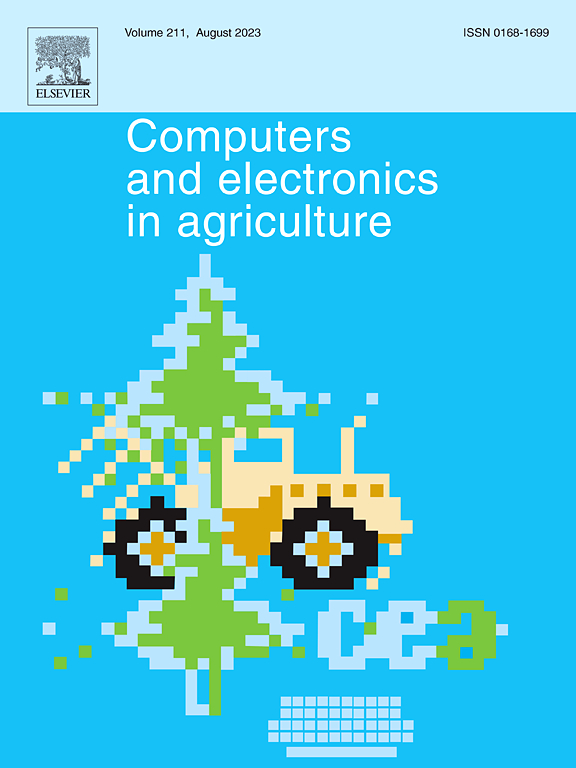使用自动编码器和变压器的智能农业的人工智能驱动的天气缩小
IF 8.9
1区 农林科学
Q1 AGRICULTURE, MULTIDISCIPLINARY
引用次数: 0
摘要
人工智能(AI)正在通过推动更智能、数据驱动的实践来重塑农业,这些实践可以增强区域天气预报并支持主动、明智的决策。大数据、物联网、遥感和机器学习的进步正在加速这种转变,变压器架构在完善农业管理战略方面越来越重要,特别是在台湾。在本研究中,我们开发了一种混合卷积自编码器和基于lstm的变压器网络(CAE-LSTMT),将6小时模拟数据缩减为精确的每小时预报,并使用中央气象局(CWA)提供的台湾焦水河流域的55,538份温度和相对湿度记录(2020-2023)进行验证。该模型经过训练(70%)、验证(10%)和测试(20%)来优化其结构和性能。该CAE-LSTMT模式大大提高了时空天气预报的分辨率,将6小时区域数据转化为每小时预报,提高了精度。与传统LSTM模型相比,该模型的温度预报增益为5.66% ~ 20.39%,相对湿度预报增益为8.05% ~ 12.76%,预报偏差较小。该模型在蒸汽压差(VPD)预测方面表现出卓越的准确性,各地区的平均绝对误差(MAE)在0.15至0.21 kPa之间,季节性误差在0.16至0.20 kPa之间,显著优于CWA模型。准确的VPD预测使农民能够管理灌溉并最大限度地减少作物压力,直接支持植物健康和产量优化。对于热指数分类,该模型的准确率高达96%,平均绝对百分比误差(MAPE)为4% ~ 23%,显著高于CWA模型的35% ~ 79%和MAPE的29% ~ 70%。这种高精度的热指数预测使农民能够保护作物和牲畜免受热应激。通过从高维数据中提取关键特征,CAE-LSTMT模型推进了多站点、多视距天气数据的环境降尺度,显示出智能农业和健康咨询系统的重大前景。这种方法提供了精确的、可操作的预测,优化了农业实践,减少了与气候有关的风险,强调了其对可持续农业和环境管理的影响。本文章由计算机程序翻译,如有差异,请以英文原文为准。

AI-driven weather downscaling for smart agriculture using autoencoders and transformers
Artificial Intelligence (AI) is reshaping agriculture by driving smarter, data-driven practices that enhance regional weather forecasting and support proactive, informed decision-making. Advances in Big Data, IoT, Remote Sensing, and Machine Learning are accelerating this transformation, with Transformer architectures increasingly pivotal in refining agricultural management strategies, especially in Taiwan. In this study, we develop a hybrid Convolutional Autoencoder and LSTM-based Transformer Network (CAE-LSTMT) to downscale six-hour simulation data into precise hourly forecasts, validated using 55,538 temperature and relative humidity records (2020–2023) from Taiwan’s Jhuoshuei River basin, provided by the Central Weather Administration (CWA). The model was trained (70 %), validated (10 %), and tested (20 %) to optimize its configuration and performance. This CAE-LSTMT model substantially enhances spatiotemporal weather forecast resolution, transforming six-hour regional data into hourly forecasts with improved accuracy. It yields temperature forecast gains of 5.66 % to 20.39 % and relative humidity improvements of 8.05 % to 12.76 %, with reduced forecast biases compared to traditional LSTM models. The model demonstrates exceptional accuracy in vapor pressure deficit (VPD) predictions, achieving mean absolute errors (MAE) between 0.15 to 0.21 kPa across regions and 0.16 to 0.20 kPa seasonally, significantly outperforming the CWA model. Accurate VPD forecasts allow farmers to manage irrigation and minimize crop stress, directly supporting plant health and yield optimization. For heat index classification, the model achieves up to 96 % ACCURACY, with mean absolute percentage errors (MAPE) of 4 % to 23 %, significantly exceeding the CWA model’s ACCURACY range of 35 % to 79 % and MAPE of 29 % to 70 %. This high precision in heat index forecasting empowers farmers to protect crops and livestock against heat stress. By extracting critical features from high-dimensional data, the CAE-LSTMT model advances environmental downscaling for multi-site, multi-horizon weather data, showing significant promise for Smart Agriculture and Health Advisory Systems. This approach offers precise, actionable forecasts, optimizing agricultural practices and reducing climate-related risks, underscoring its impact on sustainable agricultural and environmental management.
求助全文
通过发布文献求助,成功后即可免费获取论文全文。
去求助
来源期刊

Computers and Electronics in Agriculture
工程技术-计算机:跨学科应用
CiteScore
15.30
自引率
14.50%
发文量
800
审稿时长
62 days
期刊介绍:
Computers and Electronics in Agriculture provides international coverage of advancements in computer hardware, software, electronic instrumentation, and control systems applied to agricultural challenges. Encompassing agronomy, horticulture, forestry, aquaculture, and animal farming, the journal publishes original papers, reviews, and applications notes. It explores the use of computers and electronics in plant or animal agricultural production, covering topics like agricultural soils, water, pests, controlled environments, and waste. The scope extends to on-farm post-harvest operations and relevant technologies, including artificial intelligence, sensors, machine vision, robotics, networking, and simulation modeling. Its companion journal, Smart Agricultural Technology, continues the focus on smart applications in production agriculture.
 求助内容:
求助内容: 应助结果提醒方式:
应助结果提醒方式:


